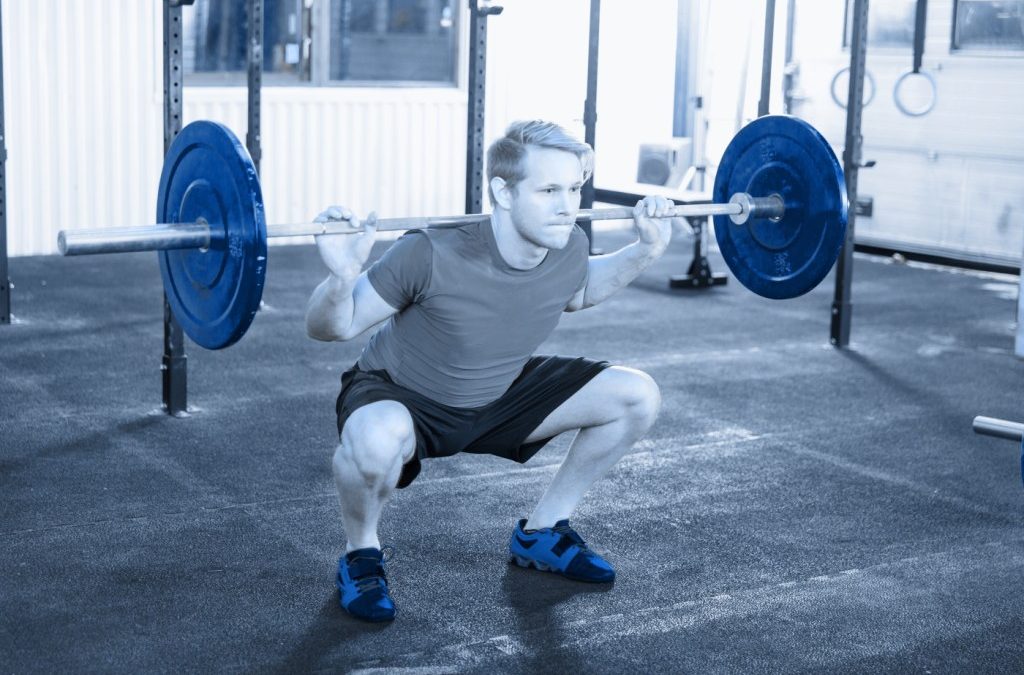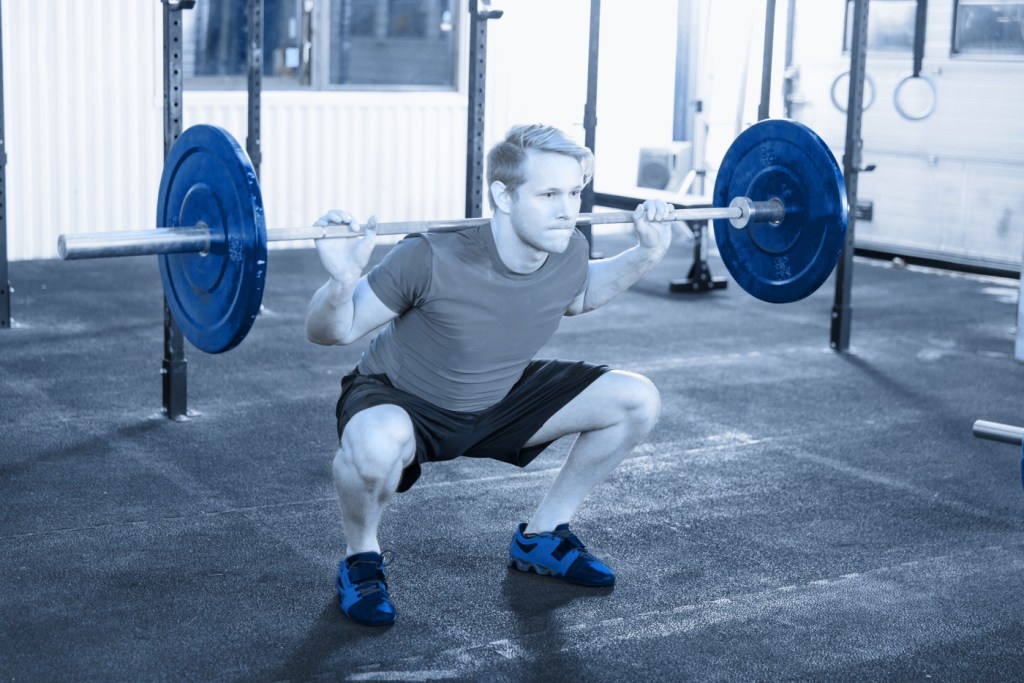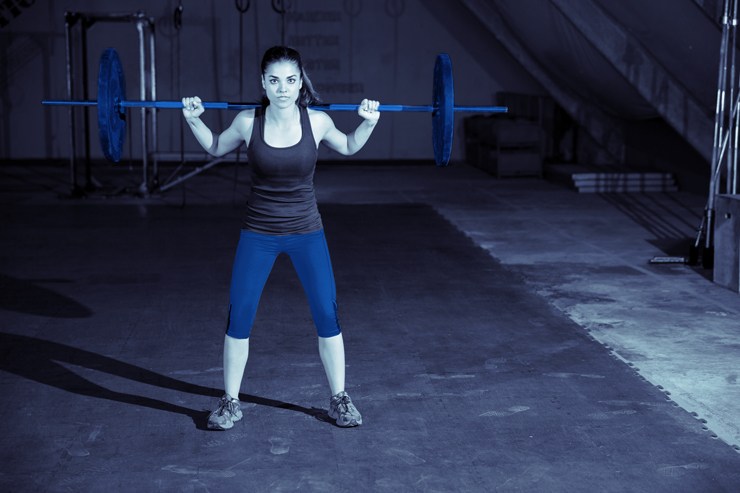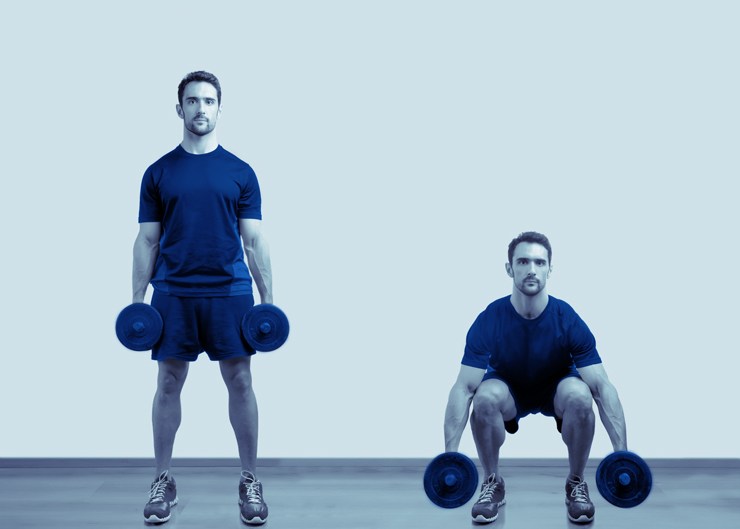Squats, especially barbell squats, are often referred to as the King of exercises. Why? It really depends on who you talk to! For some, squats are the King because they are probably the most functional exercise you can perform. Sitting down to read this article, you did a squat. You’ll do another when you get back up, another when you sit on the toilet or get in and out of your car… it’s all but impossible to get though a day without doing some squats.
Also, leg strength is vital for just about every sporting activity from running to jumping to kicking. Squats develop strength in spades.
Squats or squat variations are a great exercise for any strength training program for both men and women.
Finally, squats, especially heavy squats, are strongly linked to triggering a cascade of anabolic or muscle-building hormones to be produced inside your body. It is for this reason that squats are closely linked to not just increasing leg strength but whole body strength.
Of course, to get the most from squats and squatting you need to do them right so read on if you want to learn to master the King of exercises!
Muscles used
While squats ARE a leg exercise, in weighted squats, your upper body must work really hard to keep the bar positioned properly on your back and ensure your torso remains safely uptight. However, most people perform squats for the lower body benefits so let’s focus on those muscles. Most squatting variations strongly involve:
Quadriceps
Hamstrings
Gluteus maximus
Abductors
Adductors
Erector spinae
Core
Who are squats good for?
Squats are good for just about everyone – from aging grandmothers to Olympic sprinters. They develop the muscles that are needed in just about every daily and sporting activity. If you want increased leg size and strength, a more toned butt, to be able to jump higher or run faster, to have healthier knees, stronger bones or improve your general conditioning, squats will get it done.
Who should not do squats?
While only one study back in 1961 has ever suggested that squats were bad for your knees, if you already have knee pain, you may want to use one of the less demanding squat variants. The same is true of hip pain. A good squat does not put too much stress on your back but if you are unable to squat with impeccable form or you have a pre-existing back problem, heavy squats may not be ideal and you should choose a less weighted variation.
Finally, if you lack sufficient mobility and flexibility to squat without rounding your lower back, skip squats for now as rounding your lower back is a shortcut to injury when squatting.
Proper squat performance
Whether you are squatting 200 kg or just with your bodyweight, you need to squat properly to get the most from this exercise and avoid injury. For ease of explanation, this technique description is for barbell back squats. Most forms of squats are performed similarly and using the same main teaching points.
1. With the bar in a squat rack set at mid-chest height, duck under the bar and grab it with a wider-than shoulder-width overhand grip.
2. Push your upper back against the centre of the bar.
3. Grip the bar tightly and hold it in place on your back – pull it down so it is positioned solidly.
4. Stand up and un-rack the bar – take 1-2 steps back.
5. Stand with your feet shoulder-width apart and turn your toes out slightly.
6. Lift your chest, arch your lower back slightly and inhale.
7. Push your hips back as though you are reaching for a chair a little too far behind you. Bend your knees and, under control, sink down into a squat. Try to get your thighs parallel to the floor. Push your knees out and keep your chest up.
8. When you hit the desired depth, reverse the movement by pushing your hips up and straightening your knees. Exhale as you ascend.
9. Stand up straight, reset your position and inhale. Down you go again!
10. On completion of your set, walk back into the rack and replace the bar.
Tips for maximum benefits and mistakes to avoid
Squats are challenging so if you are going to do them, you might as well do them right! Follow these tips to ensure you get the most benefits possible with the least amount of risk. Again, most of these tips pertain to barbell back squats but many can just as easily be applied to other squat variations.
1. Wear flat, solid shoes – running shoes are great for running but that sponginess will not help you when you squat. They’ll compress and destabilize you and who needs that when you are lifting heavy weights? Instead, wear minimalist shoes, weightlifting shoes or just your socks if your gym will allow it.
2. Do not rack the bar on your neck – that really hurts! Instead, place it low on your traps and across your shoulders where the muscle mass will support the bar in relative comfort.
3. Wear a T-shirt or chalk the bar to prevent it slipping. A vest may look cooler but the sweat and subsequent slipperiness can make it really hard to hold the bar in place.
4. For heavy back or front squats, always use a squat rack. Squatting heavy weights outside of a rack can result in serious injuries.
5. Initiate all squats by pushing your hips back and then, just after, bending at the knees. This will help preserve your lower back arch and maximize the use of your hamstring and glute muscles. Breaking at the knee first is both inefficient and dangerous.
6. Keep your chest up and look directly forward at all times. Look down and you’ll round your lower back. Look up and you’ll lose hip-drive power. Keep your neck neutral.
7. Push your knees out forcefully as you descend. This will maximize your hamstring strength and prevent your knees dropping in which stresses this joint unnecessarily.
8. If your heels lift when you squat, you have tight calves. Do not ignore this problem and place plates or a slat of wood under your heels – stretch your calves more!
9. To prevent your lower back from rounding, brace your abs like someone is going to punch you in the belly.
10. Vary your foot width until you find the perfect position for you. Wider is often better for taller lifters while narrower works well for those with shorter limbs.
Variations
Barbell back squats maybe the King of exercises but with so many squat variations vying for attention, the King is only just on the top of the pile! There are lots of different ways to get your squat on so whether you are a beginner or a stone-cold expert, there is a type of squat just for you. Variations are listed in approximate order of difficulty from easy to advanced.
Bodyweight squat – the basic bodyweight squat is a great callisthenic exercise that can be performed almost anywhere. For high reps it’s a real cardio blaster too. Place your hands behind your head to develop the necessary upper body flexibility for barbell squats.
Goblet squat – a nice way to introduce squatting with weight, goblet squats involve holding a single dumbbell or kettlebell in front of your chest and just below your chin. This forces you to keep your chest up and sit back into the squat. Put a rubber resistance band around your knees to practice pushing your knees outward.
Split squat – requiring flexibility and balance, split squats place an additional emphasis on one leg at a time. Take a large step forward and then stop – get your balance. Bend your legs until your rear knee lightly touches the floor. Keep your body upright and go straight down – not forward. Stand back up and repeat. Hold dumbbells for a more demanding workout.
Front squats – with the barbell racked across the front of your shoulders instead of the back, this exercise promotes a much more upright torso position and is said to place more emphasis on your quadriceps. Preferred by athletes over the back squat, front squats require a high degree of upper body flexibility and are generally performed using a narrower than shoulder-width stance.
Hack squats – named after famous old-time wrestler George Hackenschmidt, this exercise involves placing a barbell on the floor behind your ankles, bending down and grabbing it with both hands before standing up using your legs. A tricky movement initially, this exercise will give you a very effective quad workout.
Squat jumps – performed with a light weight or no weight at all, squat jumps use the same squatting movement discussed previously but ends with a powerful leap into the air. This will develop power rather than strength – power being your ability to generate force quickly.
We know that the most important thing is the quality of the Adipex Online drug, and with them we are always sure about it.
What makes Essential to take Levitra Medication? Levitra is one of the popular generic medicine which is commonly used for the treatment of erectile dysfunction. Mostly people are facing the sexual function problem that is related to a weak penis. With the consumption of such medication, it regulates the flow of blood to penis muscles .Read more at https://levitralab.com
Overhead squats – the overhead squat builds total body strength, stability and mobility. Hold a barbell overhead using an overhand, wider-than shoulder-width grip. Squat down while keeping your arms held aloft and the weight over your feet. This exercise is tough with just an empty bar and a killer when you are hoisting heavy weights.
Pistol squats – pistols or one legged squats are hard to master but can help ensure your legs are equally developed. To perform a pistol, stand on one leg with your free leg held slightly in front of you. Squat down and simultaneously lift your free leg clear of the floor. At the bottom position your free leg should be parallel to the floor. Stand back up and repeat. Hold a weight in your hands (as per the goblet squat) to make this exercise more challenging.
Conclusion
Whatever your fitness goal, squats will get you there faster. In the old days of physical culture, exercisers squatted with religious fervour and claimed they were the key to total body fitness and strength. Squats fell out of favour because they are such hard work but hard work is what produces results and that is why they are the King of exercises!
Share this:
Click to share on Twitter (Opens in new window)
Click to share on Facebook (Opens in new window)
Click to share on Google+ (Opens in new window)
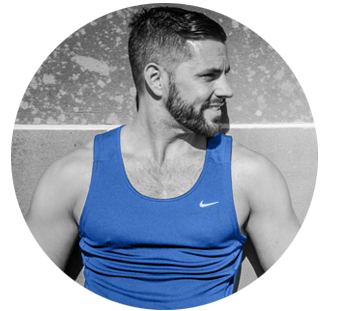
AUTHOR
Hi, my name is Dinny Morris. I’m a personal trainer and in sunny Sydney, Australia.
I work with men and women at all levels of their physical development, from overweight couch potatoes who want to get in shape, to professional athletes and natural bodybuilders who want to beef up strength and body mass.

Hi, my name is Dinny Morris. I’m a personal trainer and in sunny Sydney, Australia.
I work with men and women at all levels of their physical development, from overweight couch potatoes who want to get in shape, to professional athletes and natural bodybuilders who want to beef up strength and body mass.
